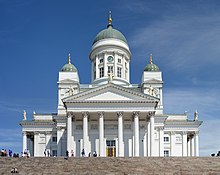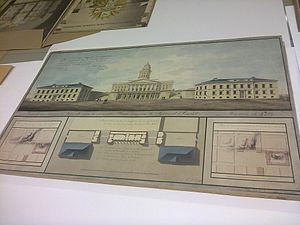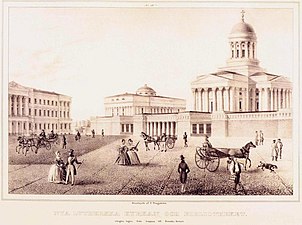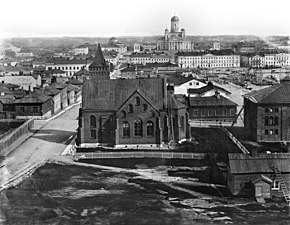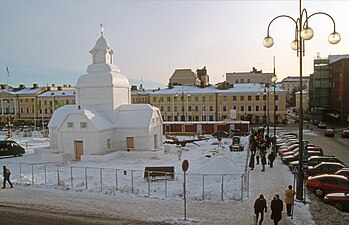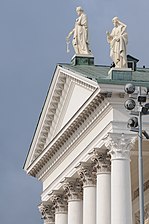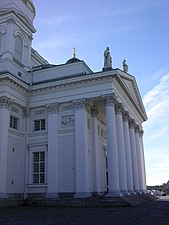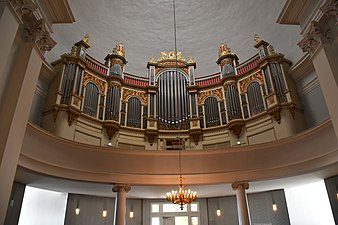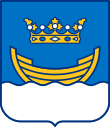
Helsinki is the capital and most populous city in Finland. It is located on the shore of the Gulf of Finland and serves as the seat of the Uusimaa region in southern Finland. Approximately 0.67 million people live in the municipality, with 1.25 million in the capital region, and 1.58 million in the metropolitan area. As the most populous urban area in Finland, it is the country's most significant centre for politics, education, finance, culture, and research. Helsinki is situated 80 kilometres (50 mi) to the north of Tallinn, Estonia, 360 kilometres (220 mi) to the north of Riga, Latvia, 400 kilometres (250 mi) to the east of Stockholm, Sweden, and 300 kilometres (190 mi) to the west of Saint Petersburg, Russia. Helsinki has significant historical connections with these four cities.

Duomo is an Italian term for a church with the features of, or having been built to serve as a cathedral, whether or not it currently plays this role. The Duomo of Monza, for example, has never been a diocesan seat and is by definition not a cathedral. In a similar way, the town of Asolo has not had its own bishop since the 10th century, but the main church is still called the Asolo Duomo. By contradistinction, the Italian word for a cathedral sensu stricto is cattedrale. There is no direct translation of "duomo" into English, leading to many such churches being erroneously called "cathedral" in English, regardless of whether the church in question hosts a bishop. Each city or town will have only one duomo, unless there are different denominations involved.
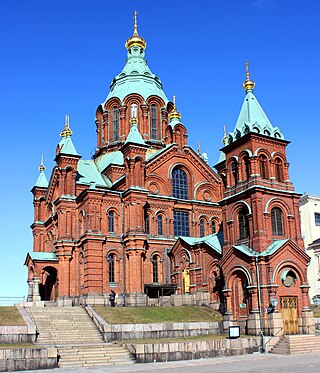
The Orthodox Church of Finland or Finnish Orthodox Church is an autonomous Eastern Orthodox archdiocese of the Ecumenical Patriarchate of Constantinople. The church has a legal position as a national church in the country, along with the Evangelical Lutheran Church of Finland.
Helsinki is the capital of Finland and is its largest city. It was founded in the Middle Ages to be a Swedish rival to other ports on the Gulf of Finland, but it remained a small fishing village for over two centuries. Its importance to the Swedish Kingdom increased in the mid-18th century when the fortress originally known as Sveaborg was constructed on islands at the entrance to the harbor. While intended to protect Helsinki from Russian attack, Sveaborg ultimately surrendered to Russia during the Finnish War (1808-1809), and Finland was incorporated into the Russian Empire as part of the Treaty of Fredrikshamn. Russia then moved the Finnish capital from Turku to Helsinki, and the city grew dramatically during the 19th century. Finnish independence, a civil war, and three consecutive conflicts associated with World War II made Helsinki a site of significant political and military activity during the first half of the 20th century. Helsinki hosted the Summer Olympic Games in 1952, was a European Capital of Culture in 2000, and the World Design Capital in 2012. It is considered a Beta Level city by the Globalization and World Cities Research Network (GaWC), according to their 2012 analysis.

Senate Square presents Carl Ludvig Engel's architecture as a unique allegory of political, religious, scientific and commercial powers in the centre of Helsinki, Finland.

Uspenski Cathedral is a Greek Orthodox or Eastern Orthodox cathedral in Helsinki, Finland, and main cathedral of the Orthodox Church of Finland, dedicated to the Dormition of the Theotokos. Its name comes from the Old Church Slavonic word uspenie, which denotes the Dormition. It is the largest Greek Orthodox church in Northern Europe.
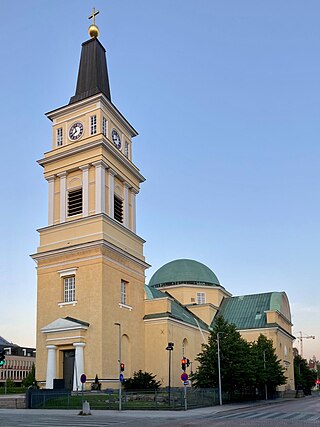
Oulu Cathedral is an Evangelical Lutheran cathedral and the seat of the Diocese of Oulu, located in the center of Oulu, Finland. The church was built in 1777 as a tribute to the king of Sweden Gustav III and named after his wife as Sofia Magdalena's church.
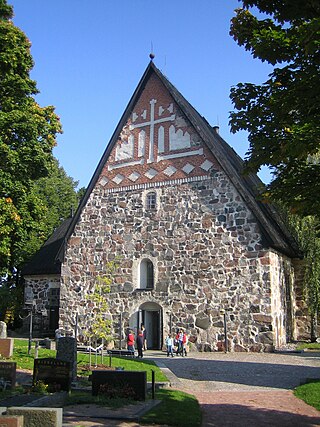
Espoo Cathedral is a medieval parish church and cathedral in Espoo, Finland. It is the seat of the Evangelical Lutheran Diocese of Espoo, established in 2004. The cathedral is located in the district of Espoon keskus, near the Espoonjoki river. The oldest parts of the church were completed in the 1480s and it is thus the oldest preserved building in the city.

The Holy Trinity Church is a Finnish Orthodox Church located in the Kruununhaka district of Helsinki, on the corner of Unioninkatu and Rauhankatu. The church was built in the neo-classical style in 1826 under the direction of the architect Carl Ludvig Engel, and was dedicated and opened in the following year. The Holy Trinity services the city's orthodox community with Divine Liturgy held in both Church Slavic and Finnish.

The Old Church of Helsinki, designed by Carl Ludvig Engel and completed in 1826, is an Evangelical Lutheran church in Helsinki. The oldest existing church in central Helsinki, the church was originally planned as a temporary building as the Ulrika Eleonora Church constructed in 1727 had become too small for the congregation and the new church, Helsinki Cathedral, would not be completed until 1852. However, the city's rapid population growth from the early 19th century onwards ensured that the church would remain needed, and also necessitated the construction of many other churches.

St. Olaf's Church, also known as Ulvila Church, is a church of the Evangelical Lutheran Church of Finland in Ulvila, Finland. The church is considered one of the best-preserved medieval fieldstone churches in Finland and is the only remaining structure from the medieval town of Ulvila. St. Olaf has been the patron saint of the church since before 1429.

Ympyrätalo is a circle-shaped office building located in the Hakaniemi district of Helsinki, Finland. The building is a local landmark.

St. Henry's Cathedral is a Catholic cathedral in Helsinki, Finland, dedicated in honor of Bishop Henrik, a 12th-century Bishop of Turku. It is the cathedral church of the Diocese of Helsinki. In terms of membership, the cathedral is the largest in Finland, with approximately 5,000 members.

Alajärvi Church, also known as the Church of Gabriel, is the main Lutheran church in the city of Alajärvi, Finland.

Ernst Bernhard Lohrmann was a German-Finnish architect born and educated in Germany but practising mainly in the Grand Duchy of Finland, where he is known especially as a designer of public buildings and more than 20 churches, many in the late Empire and Gothic Revival styles.

Pihlajavesi is a town and a former municipality of Finland, which in 1969 was merged into the municipality of Keuruu, located in the Central Finland region.
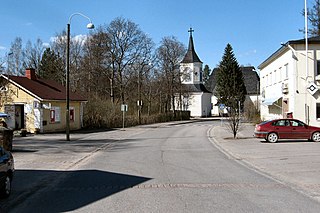
Lapinjärven kirkonkylä is the largest village and administrative center of the Lapinjärvi municipality, located on the eastern shore of Lake Lapinjärvi in Uusimaa, Finland. The distance from the village to the southern town of Loviisa is 23 kilometres (14 mi). The main road connection from the church village to Helsinki or Kouvola is Highway 6, along which the village is located.
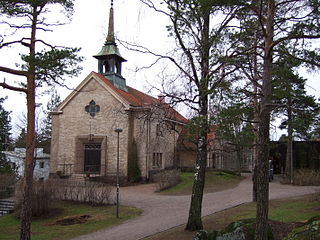
Kulosaari Church is a Lutheran church located in the Kulosaari suburb of Helsinki, Finland.
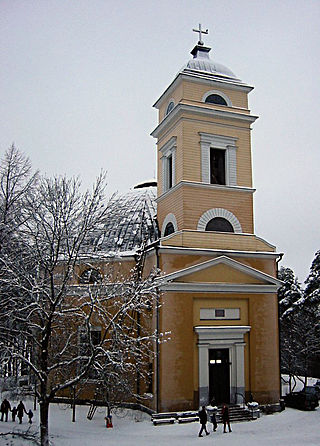
The Nokia Church is the 19th-century stone church located in the Nokia town in Pirkanmaa, Finland. The Neoclassical church building was designed by C. L. Engel (1778–1840), and it was completed in 1837.

The Klaukkala Orthodox Church, also known as St. Nectarios Church, is the 20th-century wooden Orthodox church located in Klaukkala, an urban area in the Nurmijärvi municipality in Uusimaa, Finland. The church was named after the Greek saint Nectarios of Aegina. The church also keeps the relic of Nectarios.
